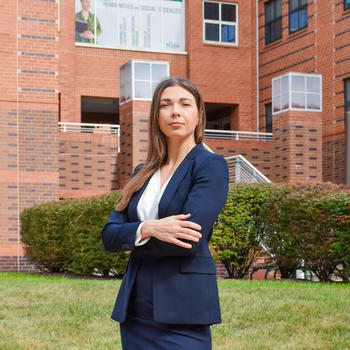Ukraine’s health care system has been hit hard amid the ongoing war. Power outages, staffing shortages, and the destruction of hospitals have added up to a drastic reduction in available care for the already-vulnerable population. In a desperate attempt to bridge the gap, Ukraine’s Ministry of Health opened the country to telehealth solutions from overseas. But will these prove to be a successful substitute for at least some necessary services, or turn out to be no better than a tech Band-Aid?
Answering that question is where Mariia Petryk, assistant professor of information systems and operations management at the Costello College of Business at George Mason University, comes in. In her spare time, she works as volunteer director of analytics for TeleHelp Ukraine (THU).

Founded by a cross-disciplinary group of Stanford students shortly after the war’s inception, THU was designed to succeed where other telemedicine initiatives in crisis-affected areas have failed. The founders worked tirelessly to assemble an international volunteer network comprising medical professionals, translators, interpreters and administrative “health navigators.” Aware that medical consultations were only part of the patient journey, THU’s founders sought to address the entire continuum of care.
Petryk stresses that while the project originated at Stanford, the technical team included “people from Chicago, Boston, other California schools…some very active volunteers were in Australia, South Korea, Canada and other countries.”
Petryk, herself of Ukrainian descent, was honored to lend her data science expertise to this worthy project. As analytics director, she manages a dozen or so number-crunching volunteers who measured and documented THU’s impact upon Ukraine’s displaced population during the initiative’s first full year.
As Petryk explains, “The Russian invasion created a humanitarian crisis where a lot of people were internally displaced. And when people relocate to a new place, they don’t know where to go for health care. They also are at higher risk for many issues, including mental health problems. And they don’t know where to turn to treat chronic diseases they may have.”
THU’s primary focus during its first year was delivering much-needed services to this population of war-ravaged internal exiles.
Petryk’s analytical work gave rise to a recent case study of THU published in Journal of Global Health. The paper’s other lead author was Aditya Narayan, a Stanford medical student and THU’s director of implementation and evaluation.
Their findings describe some impressive early successes. THU facilitated more than 1,200 virtual patient appointments from May 2022 to May 2023 alone. Despite often-chaotic conditions, patient attendance rates were above 70 percent for nine of the 13 months studied. As the first year wore on, the THU team found ways to prevent no-shows—for example, employing the popular texting platform Viber to communicate with patients and assigning an individual health navigator to each patient.
Even more impressively, 96 percent of patients reported that their health complaints were at least partially resolved during their visit.
The paper argues that aspects of THU’s model could be adapted for use in other humanitarian contexts. In its initial growth phase, THU had access to advanced technological infrastructure and a wide network of medical providers, by dint of its academic origins. This implies that partnerships with academia could be critical to replicating THU’s success outside Ukraine.
Petryk remains proud of THU’s impact and her role in helping define it. “Based on actual appointments and how much that amount of care would cost at a hospital, THU delivered an estimated $1 million worth of services in its first 13 months,” she says.
Looking ahead to THU’s future, she says, “I can only wish to see this ‘start-up,’ as it were, go for the IPO.”
For more information and to explore volunteering opportunities, visit THU’s website.
In This Story
Related News
- October 1, 2025
- September 16, 2025
- August 11, 2025
- August 5, 2025
- August 4, 2025
